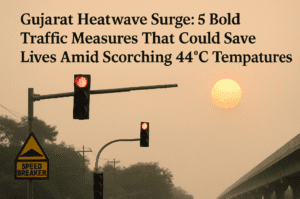Gujarat Heatwave Surge: 5 Bold Traffic Measures That Could Save Lives Amid Scorching 44°C Temperatures
A scorching heatwave continues to grip Gujarat, with the IMD forecasting daytime temperatures of 40°C–44°C until late April, affecting cities like Ahmedabad (41°C), Rajkot (42°C), and Bhuj (42.7°C). Ahmedabad authorities have disabled select traffic signals during peak afternoon hours (12–4 PM) to reduce commuter exposure to extreme heat, prioritizing public health amid rising risks of heat stress. While coastal areas like Porbandar (34°C) remain marginally cooler, dry winds and humidity amplify discomfort statewide.
The IMD warns of a further 2°C–3°C rise post-April 27, extending the heat’s intensity. Local administrations are deploying hydration stations, cooling centers, and multilingual heatstroke advisories, drawing lessons from past heatwaves like Ahmedabad’s 2013 action plan. Residents adopt adaptive strategies, from nighttime markets to traditional cooling methods, as urban planners emphasize green infrastructure and heat-resilient construction. With no immediate relief in sight, the crisis underscores the urgent need for long-term climate adaptation in India’s rapidly warming cities.

Gujarat Heatwave Surge: 5 Bold Traffic Measures That Could Save Lives Amid Scorching 44°C Temperatures
In an unprecedented move, Ahmedabad has temporarily disabled select traffic signals between noon and 4 PM to minimize heat exposure for commuters. With temperatures hitting 42°C this week, the city’s administration aims to reduce heat stress by easing traffic bottlenecks during peak sunlight hours. While 200 signals remain operational, this targeted intervention highlights the growing urgency to adapt urban infrastructure to extreme weather.
IMD’s Forecast: No Respite Until May
The India Meteorological Department (IMD) predicts Gujarat will endure maximum temperatures of 40°C–44°C until late April, with inland cities like Rajkot (42°C) and Bhuj (42.7°C) facing the brunt. Coastal areas, though slightly cooler due to sea breezes, are not spared from discomfort. Porbandar and Veraval recorded temperatures around 34°C, but humidity amplifies the perceived heat.
“Dry winds and cloudless skies are intensifying conditions,” explains AK Das, IMD meteorologist. “Coastal regions may see a 2°C–3°C rise post-April 27, extending the heat’s grip.”
Why This Heatwave Stands Out
While the IMD hasn’t declared an official heatwave, the prolonged duration of high temperatures raises concerns. Historically, Gujarat’s April heat peaks around 42°C, but the consistency of these extremes—coupled with minimal nighttime cooling—creates cumulative health risks. Ahmedabad’s 2010 heatwave, which claimed over 1,300 lives, underscores the stakes.
Cities on Alert: Public Health Measures Activated
Local governments are deploying:
- Hydration stations at transit hubs and markets.
- Awareness campaigns in regional languages about heatstroke symptoms.
- Cooling centers in municipal buildings for vulnerable groups.
Hospitals have added IV fluid stocks and designated heat wards, a strategy refined since Ahmedabad pioneered India’s first Heat Action Plan in 2013.
Citizen Adaptation: Survival Strategies in the Scorching Heat
Residents are adopting creative coping mechanisms:
- Nighttime commerce: Markets in Bhuj and Gandhinagar now operate post-sunset.
- Traditional cooling: Revisiting methods like using khus (vetiver) curtains and clay pot water.
- Tech-driven solutions: Apps like Cool Ahmedabad provide real-time shaded route maps.
Doctors emphasize hydration and electrolyte balance. “Avoid sugary drinks; opt for buttermilk or coconut water,” advises Dr. Priya Menon, a public health specialist.
The Bigger Picture: Climate Trends and Urban Planning
Gujarat’s heat surge aligns with broader climate patterns. A 2024 IMD report notes a 1.5°C average temperature rise in the state over the past decade, with April warming faster than other months. Urban experts stress the need for long-term solutions:
- Green infrastructure: Expanding tree canopies in cities like Vadodara.
- Heat-reflective roofing: Piloted in low-income neighborhoods.
- Stricter construction codes: Mandating ventilation and insulation standards.
Looking Ahead
With no immediate relief forecast, Gujarat’s heat crisis tests both resilience and innovation. As cities experiment with adaptive measures, the situation underscores a pressing truth: climate adaptation is no longer optional but a necessity. For now, the focus remains on safeguarding lives while planning for a hotter future.
You must be logged in to post a comment.